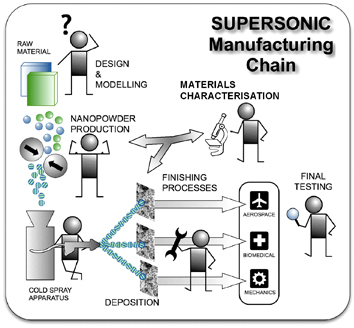| Search for content and authors |
Supersonic deposition of nano-structured surfaces |
| Jan Kusiński , Kazimierz Kowalski , Sławomir Kąc |
|
AGH University of Science and Technology, Faculty of Metals Eng. and Industrial Computer Sci., al. Mickiewicza 30, Kraków 30-059, Poland |
| Abstract |
Acronym: SUPERSONIC Title: Supersonic deposition of nano-structured surfaces Project no.: FP7-NMP-2008-LARGE-2 CP-IP 228814-2 Duration: December 1st, 2009 – November 30th, 2013
Consortium: 1. AGH University of Science and Technology, Kraków, Poland 2. MBN Nanomaterialia Spa, Carbonera, Italy 3. Katholieke Universiteit Leuven, Leuven, Belgium 4. Impact Innovations GmbH, Heldenstein, Germany 5. Universitat de Barcelona, Barcelona, Spain 6. Matres Scrl, Treviso, Italy 7. SKF Aerospace France, Saint Vallier, France 8. Alhenia AG, Baden-Dättwill, Switzerland 9. Institutul National de Cercetare, IMNR Pantelimon, Judet Ilfov, Rumania 10. Granta Design Ltd, Cambridge, United Kingdom 11. Falex Tribology NV, Rotselaar, Belgium
Objective and methods: The main aim of the project was to select coating materials, to produce powders using mechano-chemical reactions by High Energy Ball Milling (HEBM) and to deposit coatings on engineering components by means of Cold Gas Spraying (CGS) suitable for 3 different industrial applications: 1. Aeronautical: coatings for high temperature resistant and long life load bearings for front and rear aircraft pylon attachments. 2. Mechanical: abrasion resistant and fretting resistant coatings for aluminum alloys (floorboards, press-fitted gear wheel and hollow shafts in wind turbines). 3. Biomedical: a new class of nanostructure Ti based coatings intended for implant joints of elbow, knee and hip of improved performances, biocompatibility and high wear resistance. Selection of coating materials and substrates for the defined end-user applications based on experimental and theoretical feedback from the partners. Material design methodology was also aimed to establish the methods of materials characterization. Further activity consisted of development of the post deposition finishing and the process efficiency enhancement. The decisive role played the industrial end-users qualification tests of coatings. The crucial point of the project was to integrate the production of the appropriate powder with the coating technology and thus the project was focused on: 1. Investigation and development of HEBM synthesis route of reactive and non-reactive powder systems that could be suitable for final application; 2. Development of CGS equipment; 3. Development of supersonic CGS deposition process for nanostructured systems.
Results: A detailed overview of the materials characteristics identified for each application have been provided by the end-users involved in the project. Eco-design software for material selection was created. A case-by-case study to define the boundary conditions related to the performance required by the end-users provided input to this task by the creation of a knowledge capture template designed to encourage the end-users to think about the factors which would influence the selection of appropriate materials for their applications. An objective in the definition of the planning of a matrix of systems was to enhance the wear and friction characteristics of the components whilst minimizing the environmental impacts. Based on key design requirements, drawing upon feedback from thermodynamic modeling and tribological testing, and taking into account processing capabilities and constraints, the initial list of candidate material systems has been refined.  Successful systems: 1. For aeronautical applications Ni-NiSn (nickel with intermetallics) coating on steel of the following characteristics: dense, thick and nanostructured; higher hardness and better friction behavior against temperature; elevated temperature corrosion resistant; coefficient of friction better than benchmark. 2. For biomedical applications Ti-TiC (titanium reinforced) coating on Ti6Al4V alloy of the following characteristics: dense, thick and nanostructured; enhanced hardness and wear resistance; biocompatibility. 3. For mechanical applications FeCuAl-Al2O3 (FeCu reinforced by alumina) and Co-WC (WC in cobalt matrix) on aluminum alloys of the following characteristics: dense, thick and nanostructured; higher hardness and much better abrasive resistance than the substrate; coefficient of friction better than benchmark; high repeatability. For each application a powder with the right characteristics for cold spray was achieved, safety procedure for most reactive powder were well defined, some refinement work will be carried out to increase production yield and to optimize process. To achieve a high coating quality it is very important that every process step is executed with the maximum attention starting from powder production. Powder quality control involves: powder shape, size, reactivity and particle size distribution. The supersonic deposition process controlled parameters are following: feeding rate, nozzle (different, depending of deposited material) working gas temperature, variable gas pressure, particles velocity and a stand-off distance. One of the project aims is also to use reactive powders. Considerable effort was devoted to overcome problem of nozzles clogging because powder tends to react inside it and so to block it. To do this a special powder feeder as well as dedicated nozzles were developed. Some work was concentrated on setting the prequalification test of coatings and adaptation of the existing equipment for tribological experiments. The appropriate tests for the evaluation of abrasion resistance as well as fretting wear resistance of the coatings have been defined. |
| Legal notice |
|
| Related papers |
Presentation: Polish Research Projects at Nano and Advanced Materials Workshop and Fair, by Kazimierz KowalskiSee On-line Journal of Nano and Advanced Materials Workshop and Fair Submitted: 2013-07-19 11:48 Revised: 2013-07-19 13:54 |